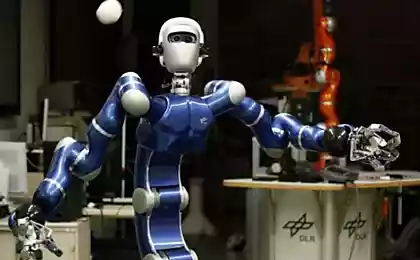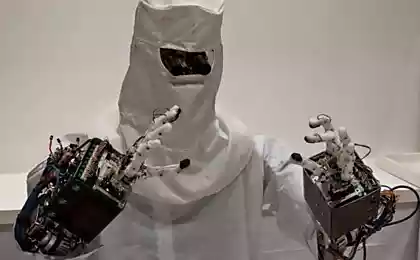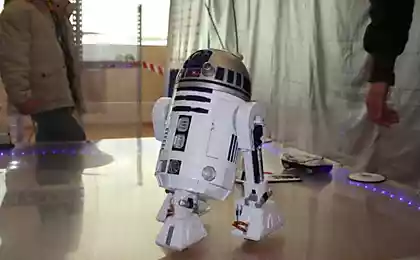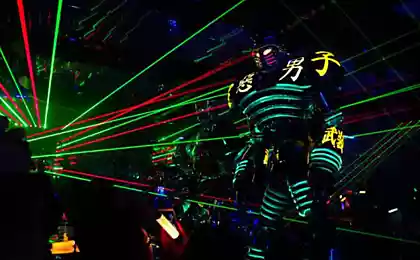581
Robots could replace guide dogs
Robots are already being accused of that they take away jobs from people, and now the machine has eyes for guide dogs. The researchers developed a "robot with the reins", which can help people to navigate in space with the help of tactile sensors and vibration.

The proof-of-concept now resembles a vacuum cleaner or a lawn mower, but future versions may be smaller and easier to use at home. Engineers said that such robots can be used by firefighters for example, they will help to Wade through the smoke-filled building for easier detection of people.
Small mobile robots are equipped with sensors, pointing the way, and the users will follow them at a distance of 3 feet (one meter), holding "the check." Special sleeve that covers the arm of the user is equipped with an electronic microvibrator.
Such a sleeve can transmit the data sent by the robot, a blind person, fireman or other user needs to interpret them. Such a vibration will provide data on size, shape, and even hardness of any object found by the robot.
This robot, potentially life-saving, was developed by the Royal College in London and Sheffield University, with funding from the Research Council engineering and physical Sciences (EPSRC):
Jacques Penders from Sheffield University explained that during the four years of the project, the team used a haptic robot in a variety of situations and locations — from the University gym, to the smoke-filled caverns in Germany. The robot can sense any hesitation or resistance from the user and adapt to his pace.
In addition, the robot is programmed to predict the next user action based on how he moves, and his previous actions. During testing, the blind, the volunteers followed the robot and the algorithm of "the guide" was able to determine their level of trust.
Dr. Crisanta Nanayakara from king's College London said:
We have made important advances in understanding the interaction between the "robot man" and applied them in the classic life of an emergency situation where every second counts. Robots with the reins can add an invaluable extra dimension to the capabilities of the firefighters.
Senior designer Heath reed from the University of Sheffield added:
Using robots in emergency situations, even in their early stages of development, it is important to develop an understanding of how robotics interact with people and how these relationships can be explored. This project opens the way for robotics to develop in a range of sectors. I believe that in the next five years we will see some real development on the basis of our research. Among the partners of the project — charity guide dogs, fire and rescue service in South Yorkshire and Thales Ltd. The researchers built a proof of concept and plan to create a full working prototype to test in realistic conditions in the next few months.published
P. S. And remember, only by changing their consumption — together we change the world! ©
Source: www.robo-hunter.com/news/roboti-smogut-zamenit-sobak-povodirei

The proof-of-concept now resembles a vacuum cleaner or a lawn mower, but future versions may be smaller and easier to use at home. Engineers said that such robots can be used by firefighters for example, they will help to Wade through the smoke-filled building for easier detection of people.
Small mobile robots are equipped with sensors, pointing the way, and the users will follow them at a distance of 3 feet (one meter), holding "the check." Special sleeve that covers the arm of the user is equipped with an electronic microvibrator.
Such a sleeve can transmit the data sent by the robot, a blind person, fireman or other user needs to interpret them. Such a vibration will provide data on size, shape, and even hardness of any object found by the robot.
This robot, potentially life-saving, was developed by the Royal College in London and Sheffield University, with funding from the Research Council engineering and physical Sciences (EPSRC):
Jacques Penders from Sheffield University explained that during the four years of the project, the team used a haptic robot in a variety of situations and locations — from the University gym, to the smoke-filled caverns in Germany. The robot can sense any hesitation or resistance from the user and adapt to his pace.
In addition, the robot is programmed to predict the next user action based on how he moves, and his previous actions. During testing, the blind, the volunteers followed the robot and the algorithm of "the guide" was able to determine their level of trust.
Dr. Crisanta Nanayakara from king's College London said:
We have made important advances in understanding the interaction between the "robot man" and applied them in the classic life of an emergency situation where every second counts. Robots with the reins can add an invaluable extra dimension to the capabilities of the firefighters.
Senior designer Heath reed from the University of Sheffield added:
Using robots in emergency situations, even in their early stages of development, it is important to develop an understanding of how robotics interact with people and how these relationships can be explored. This project opens the way for robotics to develop in a range of sectors. I believe that in the next five years we will see some real development on the basis of our research. Among the partners of the project — charity guide dogs, fire and rescue service in South Yorkshire and Thales Ltd. The researchers built a proof of concept and plan to create a full working prototype to test in realistic conditions in the next few months.published
P. S. And remember, only by changing their consumption — together we change the world! ©
Source: www.robo-hunter.com/news/roboti-smogut-zamenit-sobak-povodirei























